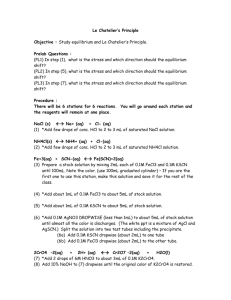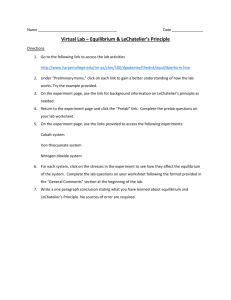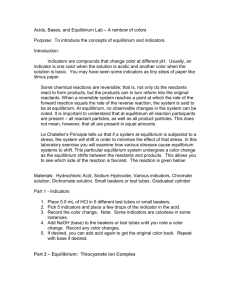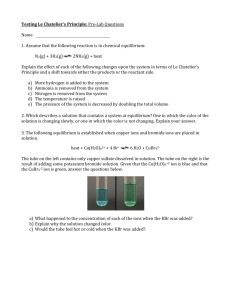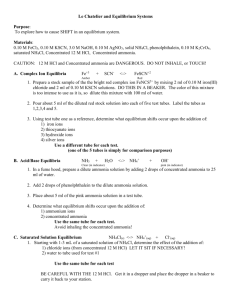Chem 140
advertisement
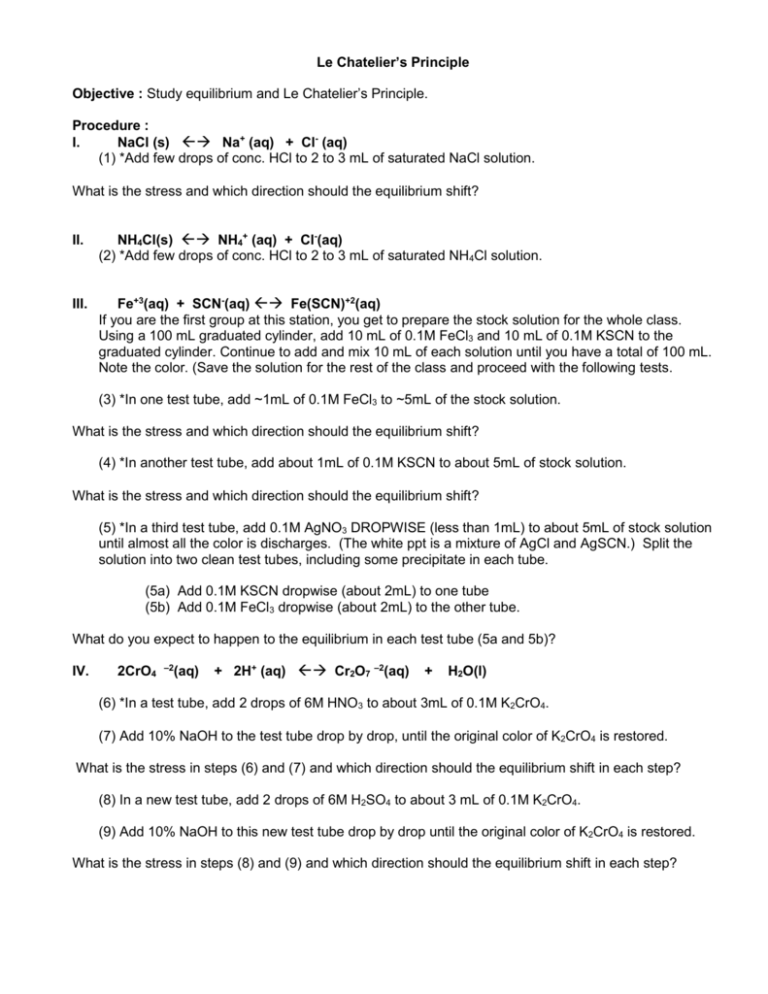
Le Chatelier’s Principle Objective : Study equilibrium and Le Chatelier’s Principle. Procedure : I. NaCl (s) Na+ (aq) + Cl- (aq) (1) *Add few drops of conc. HCl to 2 to 3 mL of saturated NaCl solution. What is the stress and which direction should the equilibrium shift? II. NH4Cl(s) NH4+ (aq) + Cl-(aq) (2) *Add few drops of conc. HCl to 2 to 3 mL of saturated NH4Cl solution. III. Fe+3(aq) + SCN-(aq) Fe(SCN)+2(aq) If you are the first group at this station, you get to prepare the stock solution for the whole class. Using a 100 mL graduated cylinder, add 10 mL of 0.1M FeCl3 and 10 mL of 0.1M KSCN to the graduated cylinder. Continue to add and mix 10 mL of each solution until you have a total of 100 mL. Note the color. (Save the solution for the rest of the class and proceed with the following tests. (3) *In one test tube, add ~1mL of 0.1M FeCl3 to ~5mL of the stock solution. What is the stress and which direction should the equilibrium shift? (4) *In another test tube, add about 1mL of 0.1M KSCN to about 5mL of stock solution. What is the stress and which direction should the equilibrium shift? (5) *In a third test tube, add 0.1M AgNO3 DROPWISE (less than 1mL) to about 5mL of stock solution until almost all the color is discharges. (The white ppt is a mixture of AgCl and AgSCN.) Split the solution into two clean test tubes, including some precipitate in each tube. (5a) Add 0.1M KSCN dropwise (about 2mL) to one tube (5b) Add 0.1M FeCl3 dropwise (about 2mL) to the other tube. What do you expect to happen to the equilibrium in each test tube (5a and 5b)? IV. 2CrO4 –2 (aq) + 2H+ (aq) Cr2O7 –2(aq) + H2O(l) (6) *In a test tube, add 2 drops of 6M HNO3 to about 3mL of 0.1M K2CrO4. (7) Add 10% NaOH to the test tube drop by drop, until the original color of K2CrO4 is restored. What is the stress in steps (6) and (7) and which direction should the equilibrium shift in each step? (8) In a new test tube, add 2 drops of 6M H2SO4 to about 3 mL of 0.1M K2CrO4. (9) Add 10% NaOH to this new test tube drop by drop until the original color of K2CrO4 is restored. What is the stress in steps (8) and (9) and which direction should the equilibrium shift in each step? V. Co(H2O)6 +2(aq) + 4Cl-(aq) CoCl4 –2(aq) + 6 H2O (10) *Add about 3mL of Conc. HCl solution dropwise to about 2mL (no more than) of 0.1M CoCl2. (11) Add water to (10) until the reverse reaction is evident. What is the stress and which way does the equilibrium shift? VI. NH3(g) + H2O(l) NH4+ (aq) + OH-(aq) (12) *Dissolve a very small amount of solid NH4Cl in about 5 mL of stock NH4OH solution. (13) *Add a few drops of 6M HCl to about 5mL stock NH4OH solution. Prelab: Write your procedure in your notebook. Answer the questions included within the procedure. Postlab: In addition to reporting your data results, conclusions, learning, problems, and errors, answer the following. (Q1) In steps (1-4), which direction DID the equilibrium shift? What was the visual indication of the shift? (Q2) Write a balanced net ionic equation showing what happened in step (5). (Q3) In steps (5a and 5b), what is the stress and which direction DID the equilibrium shift? What was the visual indication of the shift? Use the balanced equation from (Q4). (Q4) In steps (6, 7), which direction DID the equilibrium shift? What was the visual indication of the shift? (Q5) In steps (8, 9), which direction DID the equilibrium shift? What was the visual indication of the shift (Q6) In steps (10, 11), which direction DID the equilibrium shift? Using balanced equations, explain the direction of this shift. (Q7) In steps (12, 13), which direction DID the equilibrium shift? Using balanced equations, explain the direction of this shift Summary Rewrite the six chemical equations given in the procedure above. Under each component, write its qualitative characteristic, such as color, opaque, clear, precipitate, hot, cold, etc. For example, A + B C + D (light blue) (no color) (red) (pink in the presence of indicator) Make sure to include HEAT as a reactant or product if now known.
